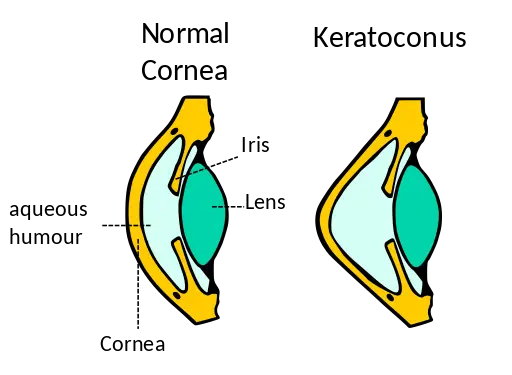Corneal Cross Linking For Keratoconus
Corneal Cross Linking is a quick, minimally invasive procedure to prevent progression of keratoconus. Learn more about Corneal Cross Linking at Angel Eyes.
What is corneal cross linking?
Corneal cross linking is a procedure that is used to stop the progression of keratoconus (thinning of the cornea).
During the procedure, vitamin B2 (riboflavin) drops are applied to the cornea for a few minutes. Then, UV light is applied for another few minutes. The UV light creates a chemical reaction with the riboflavin drops which increases the bonds between the collagen fibres within the cornea. This results in strengthening of the cornea which stops the progression of keratoconus.
What is keratoconus?

The clear window of the front of the eye (cornea) is usually of a round shape. Keratoconus is a condition that causes progressive thinning of the cornea and changes its shape to more like a cone shape. Keratoconus causes progressive reduction and distortion of vision.
In advanced cases, vision can be severely reduced as a result of scarring.
Key Benefits of Collagen Cross Linking
Stabilization of vision: Cross linking stabilizes and in some cases, improves vision.
Restored corneal strength: Cross linking strengthens corneal tissue and stops the progression of keratoconus.
Minimally invasive with quick recovery: Cross linking is a minimally invasive procedure performed in a few minutes using just numbing drops. No stitches or sutures are used.
Reduced need for corneal transplant: By preventing progression of keratoconus, most patients avoid corneal transplant surgery.
Cross Linking Technologies at Angel Eyes

Angel Eyes uses the Appasamy CL-UVR Rapid Cross Linking Machine:
Rapid Treatment Time: Can perform treatment in as little as 3 minutes
Adjustable Energy Level: Capable of performing both traditional and rapid treatments. Does not harm the corneal endothelium
Illumination System: Clustering illumination system with dual aiming beam to achieve effective homogeneous radiation of UV beam.
Corneal Cross Linking
Starting From-
Initial Consultation
-
Full Work-Up Scans and Tests
-
Procedure
-
Follow-up Appointments
Frequently Asked Questions
Is corneal crosslinking comfortable?
During cross linking, anaesthetic numbing drops are used to prevent pain.
I have advanced keratoconus. Is corneal crosslinking suitable for me?
For cross linking, minimum corneal thickness of 400 microns is required. This is to prevent damage to the inner healthy corneal layers. Your suitability for cross linking will be assessed during the pre-operative consultation.